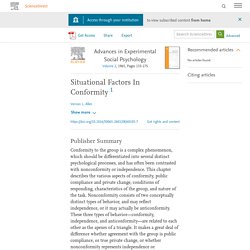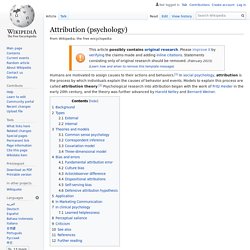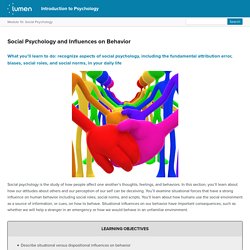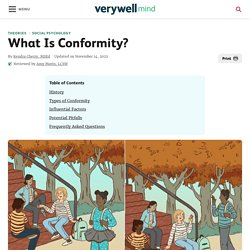

Conformity refers to pressures to behave to obey certain rules and regulations and these rules as known as social norms.
How much do we conform to the workplace? There are two factors we shall discuss as behaviors determined by internal factors and by the immediate environment. These factors going to shape our final behaviors.
Part 2: Short Essay (60 marks)
Dispositional and situational sources of control: Relative impact on work-family conflict and positive spillover. Introduction. Rotter (1966) - Locus of control. Personality and situational determinants of conformity. Discussion. Self-Monitoring and Conformity: A Comparison of Self-Report and Behavioral Measures. Introduction. Discussion. Situational and dispositional predictors of displays of positive emotions. Personality and displayed positive emotions. Conformity in the Workplace. Factors that Influence Conformity. Why Do We Conform?
Situational Factors In Conformity. Conformity to the group is a complex phenomenon, which should be differentiated into several distinct psychological processes, and has often been contrasted with nonconformity or independence.

This chapter describes the various aspects of conformity, public compliance and private change, conditions of responding, characteristics of the group, and nature of the task. Attribution (psychology) The process by which individuals explain the causes of behavior and events Ex.
Three-dimensional model Bernard Weiner proposed that individuals have initial affective responses to the potential consequences of the intrinsic or extrinsic motives of the actor, which in turn influence future behavior.[12] That is, a person's own perceptions or attributions as to why they succeeded or failed at an activity determine the amount of effort the person will engage in activities in the future. Weiner suggests that individuals exert their attribution search and cognitively evaluate casual properties on the behaviors they experience. When attributions lead to positive affect and high expectancy of future success, such attributions should result in greater willingness to approach to similar achievement tasks in the future than those attributions that produce negative affect and low expectancy of future success.[13] Eventually, such affective and cognitive assessment influences future behavior when individuals encounter similar situations. Weiner's achievement attribution has three categories: stable theory (stable and unstable) locus of control (internal and external) controllability (controllable or uncontrollable) Stability influences individuals' expectancy about their future; control is related with individuals' persistence on mission; causality influences emotional responses to the outcome of task. – ymgoi001
A child attributes their feelings to the weather outside their house; it is raining outside, because it is raining outside the child feels sad.

Ex. A child attributes the weather to their feelings; the child is feeling sad, because the child is feeling sad it is raining outside. Weiner's achievement attribution has three categories: Social Influence Revision Notes. Social influence is the process by which an individual’s attitudes, beliefs or behavior are modified by the presence or action of others.

Four areas of social influence are conformity, compliance and obedience, and minority influence. Conformity / Majority Influence Conformity is a type of social influence defined as a change in belief or behavior in response to real or imagined social pressure. It is also known as majority influence. Compliance AO1 This refers to instances where a person may agree in public with a group of people, but the person privately disagrees with the group’s viewpoint or behavior. For a study on compliance refer to Asch's Line Study. Internalisation AO1 Publicly changing behavior to fit in with the group while also agreeing with them privately. For a study on internalisation refer to Jenness (see below). Identification AO1 Identification occurs when someone conforms to the demands of a given social role in society. A good example is Zimbardo's prison study. Social Psychology and Influences on Behavior. What you’ll learn to do: recognize aspects of social psychology, including the fundamental attribution error, biases, social roles, and social norms, in your daily life Social psychology is the study of how people affect one another’s thoughts, feelings, and behaviors.
Situational and Dispositional Influences on Behavior Behavior is a product of both the situation (e.g., cultural influences, social roles, and the presence of bystanders) and of the person (e.g., personality characteristics). Subfields of psychology tend to focus on one influence or behavior over others. Situationism is the view that our behavior and actions are determined by our immediate environment and surroundings. In contrast, dispositionism holds that our behavior is determined by internal factors (Heider, 195😎. An internal factor is an attribute of a person and includes personality traits and temperament. Social psychologists have tended to take the situationist perspective, whereas personality psychologists have promoted the dispositionist perspective. Modern approaches to social psychology, however, take both the situation and the individual into account when studying human behavior (Fiske, Gilbert, & Lindzey, 2010). In fact, the field of social-personality psychology has emerged to study the complex interaction of internal and situational factors that affect human behavior (Mischel, 1977; Richard, Bond, & Stokes-Zoota, 2003). – ymgoi001
In this section, you’ll learn about how our attitudes about others and our perception of our self can be deceiving.

You’ll examine situational forces that have a strong influence on human behavior including social roles, social norms, and scripts. You’ll learn about how humans use the social environment as a source of information, or cues, on how to behave. Situational influences on our behavior have important consequences, such as whether we will help a stranger in an emergency or how we would behave in an unfamiliar environment. Learning Objectives Social psychology examines how people affect one another, and it looks at the power of the situation. Figure 1. How Does Conformity Influence Behavior?
Conformity involves changing your behaviors in order to "fit in" or "go along" with the people around you.

In some cases, this social influence might involve agreeing with or acting like the majority of people in a specific group, or it might involve behaving in a particular way in order to be perceived as "normal" by the group. Definitions Psychologists have proposed a variety of definitions to encompass the social influence that conformity exerts. What is Conformity? What is Conformity?

By Saul McLeod, updated 2016 Conformity is a type of social influence involving a change in belief or behavior in order to fit in with a group. This change is in response to real (involving the physical presence of others) or imagined (involving the pressure of social norms / expectations) group pressure. Conformity can also be simply defined as “yielding to group pressures” (Crutchfield, 1955). Group pressure may take different forms, for example bullying, persuasion, teasing, criticism, etc.